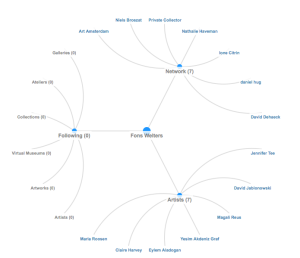We ended our last post about digitalization of the art world with 2 images which illustrate quite well what’s going on. The first – a screenshot of Jan Hoet’s profile on the Open Art Collection – was… empty. Although a member since 2010, Jan Hoet has 0 friends, 0 galleries, 0 collectors and artists linked to him on the platform. What a contrast with his offline address book, probably one of the most valuable items in Belgian art world and beyond. The second screenshot – a tweet from @artamsterdam about the first sale on the virtual art fair – shows how painfully underperforming this platform is (first sale on Saturday, while fair was open from Wednesday).
So why are virtual art fairs failing? One of the reasons is the way most of these initiatives approach the digital space. They seem to lack every understanding of how digital works and simply try to copy what is happening off-line in an online environment.
Let’s take Art Amsterdam Online as example. This virtual art fair is hosted on Open Art Collection platform. After spending 5 minutes on this platform, clicking left and right, you will already hit the first barrier: you need a subscription.
Although we understand that a viable online initiative needs a revenue model, a subscription model for access seems difficult in our eyes. In an online context, people are prepared to pay for value, rarely for simple access.
The second barrier we found was the closed architecture of the platform. It was impossible to connect with Facebook or LinkedIn although that’s where most collectors, galleries and artists have their social contacts.
 The third barrier is the lack of value creation on the platform. The “network view” is an interesting starting point but it doesn’t really do much. Why not copy best practices of LinkedIn, Facebook and Flickr and build a real community, focusing on creation of social currency? Enriching the profiles of members by letting them use the platform to interact with each other and even present their current collection would be a step in the right direction.
The third barrier is the lack of value creation on the platform. The “network view” is an interesting starting point but it doesn’t really do much. Why not copy best practices of LinkedIn, Facebook and Flickr and build a real community, focusing on creation of social currency? Enriching the profiles of members by letting them use the platform to interact with each other and even present their current collection would be a step in the right direction.
The last aspect we would like to highlight is the lack of a strong interface, visually, as well as on level of usability. The way artworks are presented here is far from attractive & doesn’t invite one to browse and discover further.
We will tackle these aspects in further detail in our next post, by looking at the virtual art fairs from the experience angle.


